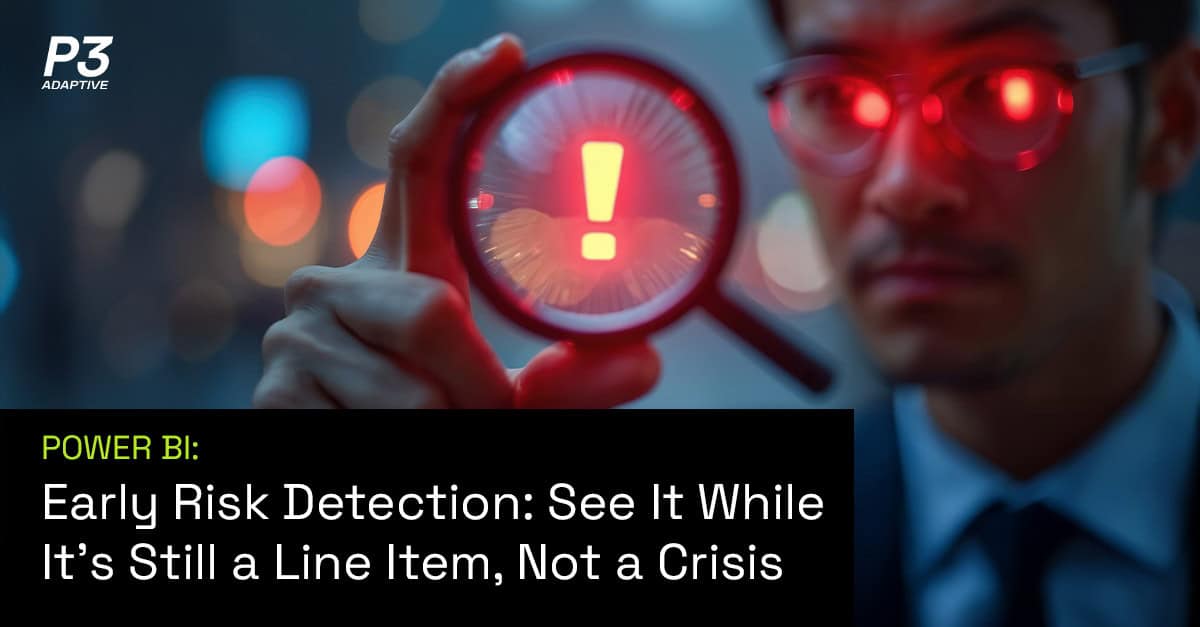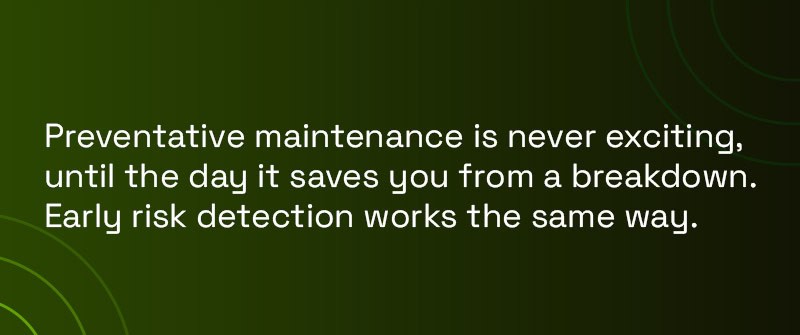
The Real Win Is Spotting Trouble While It’s Still Small Enough to Ignore.
Great leaders don’t just react fast, they stay ahead. They spot risks early, when problems are still small enough to fix, long before they turn into costly crises. That skill (early risk detection)separates companies that scramble from companies that lead. It isn’t about guessing the future. It’s about having the systems, the data, and the habits that reveal problems before they have a chance to grow.
Early risk detection isn’t a luxury. It’s not just nice-to-have. It’s the foundation of resilient leadership. When you can see what’s shifting inside your business as it happens, not weeks or months later, you gain something rare: time. Time to act smart, not just fast.
When small shifts can snowball quickly, early risk detection gives your business the breathing room to adapt. And that is how you move from firefighting to forward-thinking.
Why Early Risk Detection Beats Crisis Management Every Time
No one builds their best strategy in the middle of a crisis. By the time the problem shows up in the numbers or the headlines, the easy options are already gone.
Early risk detection changes that and flips the script. Instead of playing defense, you’re steering the course before trouble even shows up. It’s the business equivalent of spotting a low tire pressure warning before a blowout ruins your long anticipated vacation . . . before you even get to the airport.
Companies that master early risk detection don’t avoid problems, they avoid surprises. They catch the warning signs early, while solutions are simple and inexpensive, not complex and costly.
If you wait until the data says “urgent,” you’ve already lost ground. The smartest move is to see the risk while it’s still a line item, not a crisis.
Why Risks Get Missed (Even by Good Teams)
Most teams don’t miss risks because they’re inattentive. They miss them because the signs are subtle, and the systems they rely on are slow or disconnected. When early risk detection is missing, it’s often because of a few common roadblocks.
- Scattered Data: Key insights are trapped in siloed systems. Finance sees one version. Sales sees another. Operations has a third.
- Lagging Reports: Most reporting shows what happened last month, not what’s starting to happen now.
- Reactive Focus: When teams are busy explaining the past, they’re not scanning for what’s next.
Each of these issues slows the signal. Without real-time, unified data, early risk detection turns into guesswork, and guesswork isn’t a viable strategy. The good news is these are not hard problems to solve. With the right approach, you can build a system that helps you see risks while they’re still small enough to manage.
What Early Risk Detection Looks Like
Early risk detection isn’t magic. It’s not about predicting every future event. It’s about building a system that shows you the present with clarity and speed, a system smart enough to flag risks before they have a chance to grow.
Here is what that system needs to have.
- Unify Your Data: Disparate systems hide problems. A true early risk detection system pulls your data into one source of truth.
When you have clean, connected data, patterns emerge faster. Risks stand out. And decisions get a lot easier. That’s where platforms like Power BI and Microsoft Fabric shine. They don’t just visualize your data, they make it usable in real time. - Shift to Real-Time Visibility: Waiting for end-of-month reports is waiting too long. Real early risk detection happens in real time. Dashboards should update as events happen, not weeks later. Tools like Power BI give leaders a live view of the business, not just a snapshot of the past, so you can move before risks gain momentum.
- Focus on Leading Indicators: Lagging indicators tell you what’s already broken. Leading indicators show you what’s about to crack. Is deal velocity slowing down? Are supply chain delays creeping up? Are customer churn rates edging higher? These signals are the whispers before the alarm. Early risk detection means tuning into them and building systems that don’t just report the big news, they hint at the early signs.
- Automate the Nudge: You absolutley do not need more dashboards. You need smarter ones, dashboards that tap you on the shoulder when something is off. Automated alerts for key shifts in your data, a dip in on-time deliveries, a spike in overdue payments, can turn slow creep into fast action. Set thresholds. Trust the alerts. Let your system flag the risks before they become crises.
These aren’t one-time changes. They’re habits that compound over time. Companies that build early risk detection into their daily rhythm aren’t just reacting better, they’re thinking faster.
Why It Feels Like Preventative Maintenance
Preventative maintenance is never exciting, until the day it saves you from a breakdown. Early risk detection works the same way.

It’s the difference between a quick adjustment and a painful recovery. The businesses that succeed long term aren’t the ones that dodge every challenge. They’re the ones that catch trouble before it spirals. Small investments now prevent huge costs later. Smart leaders build early risk detection into their business the same way, quietly, steadily, and before anyone else realizes it’s needed.
Real-World Early Risk Detection in Action
Early risk detection isn’t pure theory. It’s already helping businesses make smarter moves across every department.
- In finance, it looks like daily tracking of overdue invoices. Instead of reacting when cash flow tightens, you adjust the terms, follow up faster, and protect your liquidity before it’s strained.
- In sales, it’s about monitoring pipeline velocity, how fast deals move through stages. If things slow down, early risk detection lets you intervene while there’s still time to course-correct, not just explain a miss at the end of the quarter.
- In operations, it means weekly monitoring of supplier performance. A subtle shift in on-time delivery rates today can signal bigger supply chain problems tomorrow. Catch it early, and you can act before delays cascade.
These examples aren’t isolated wins. They’re signs of a business that has built early risk detection into its DNA and reaps the rewards by staying steps ahead.
How to Build It Into Your Business
If this sounds like something only big enterprises can do, think again. This process doesn’t require massive budgets or complex overhauls. It starts with a few strategic moves.
- Connect your systems. Unified data is the foundation.
- Invest in live dashboards. Replace static reports with real-time updates.
- Define your leading indicators. Focus on a handful of early signs that really move the needle.
- Automate smart alerts. Let the system nudge you before trouble has a chance to take root.
The goal isn’t more noise or more dashboards, it’s clarity. Early risk detection clears the fog and shows you where to steer.
Making It Practical
This isn’t a tool you plug in. It’s a discipline: part strategy, part habit, and part smart use of technology. That’s where P3 Adaptive comes in. We help mid-market businesses turn scattered, slow-moving data into a connected, decision-ready asset. Using platforms like Power BI and Microsoft Fabric, we design the systems and strategies that make early risk detection not just possible, but practical.
We don’t just drop in dashboards and walk away. We work alongside your team, build a live data foundation, and help you spot the risks others miss before they become crises. Because staying ahead isn’t about having more tools. It’s about having the right partner to help you put them to work.
Early risk detection doesn’t just protect your business. It gives you the clarity to lead it.
Ready to Lead the Way
Early risk detection isn’t about fear. It’s about clarity. It is the difference between reacting under pressure and moving with purpose. The best leaders are already building systems that show them the road ahead, not just the road behind. They are making faster decisions because they can see further. They are shaping outcomes before crises take shape.
When you’re ready to turn early signals into smart moves, we’re ready to help you get it done. Because leadership is never just about seeing what is coming. It is about shaping what happens next.
Get in touch with a P3 team member